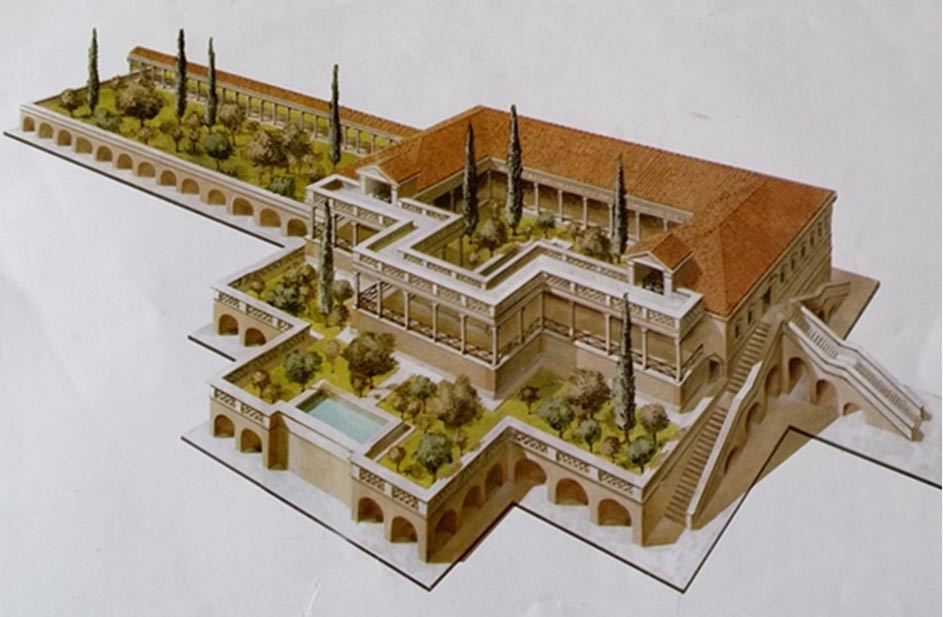Ancient villa ruins found to be the estate of chariot-racer and Ben-Hur rival
Thousands of years ago, a fire ripped through a beautiful seaside villa on the Tuscan island of Elba.
Archaeologists uncovering the ruins now have evidence identifying the ruined villa as belonging to Marcus Valerius Messalla Corvinus, a man portrayed in a 20 th century film as chariot racing rival to the hero Ben-Hur.
While the 1959 movie ‘Ben-Hur’ was fictional, the Roman general Marcus Valerius Messalla Corvinus was very much real, and inspired the ‘Messalla’ character from the novel and film.

The chariot race scene from the 1959 film, Ben-Hur. Metro-Goldwyn-Mayer/Wikimedia commons Fair Use
It was his estate which was destroyed by fire, only to be excavated 2000 years later, and identified through items buried just below the villa.
The once-glorious villa overlooked the Gulf of Portoferraio, on Elba Island, Italy. Dating back to the 1st century B.C., its distinctive arched walls led it to be dubbed Villa delle Grotte, ‘the Caves’. Long thought to have been owned by the Roman Messalla family, the team of archaeologists led by Franco Cambi, professor of methodology of archaeological research at the University of Siena, were able to confirm this belief with ancient remains found under the collapsed building.
According to Discovery News, "archaeologists Laura Pagliantini, Luisa Zito and Luisa Quaglia, of the Archeo Color Association,[say] the now ruined villa, which is currently closed to the public, has long been associated to Messalla’s patrician family but no evidence was ever found to confirm the speculation.”
Excavations in the 1960s revealed ancient gardens, terraces and stairways with views of the sea. A grand ornamental pool, grey and black mosaic floors, and thermal baths decorated with frescoes and marble statuary demonstrated the wealth and luxury of the holiday estate.
Recent excavations revealed five large dolia beneath the farm serving the estate. They bear Latin inscriptions stamped on their sides, citing their creator and owner by name. The dolia – large clay vases - could hold up to 1,500 liters of wine.

Dolia found under the once-magnificent Villa le Grotte bear inscriptions suggesting the identity of the owners. Credit: Laura Pagliantini

Dolium from another Roman villa (Minori, Italy). Wikimedia Commons
Discovery News reports, “The vases were stamped with the Latin inscription ‘Hermia Va(leri) (M)arci s(ervus) fecit,’ meaning ‘Made by Hermias, slave of Marcus Valerius.’ Other stamps on the vases feature the words ‘HE’ for Hermia, and a carved dolphin.”
The dolphin and inscription refers to an ancient tale about a boy from Turkey named Hermias who died in a storm and was mourned by dolphins, notes International Business Times.
MORE
- Archaeologists discover hidden slave tunnel beneath Hadrian’s Villa
- The legendary Spartacus: Gladiator and leader of slaves against the Romans
- Ancient industrial-scale wine press and monastery discovered
While a fire destroyed the farm and estate, the heat served to harden raw clay vessels and other artifacts, preserving them and their details. However, the estate was abandoned in the 1 st century A.D., as nothing of value remained after the fire.

View of the coast (Portoferraio) of the Elba island. Bruno Barral/Wikimedia Commons

Villa Le Grotte (the Caves), so-named because of the shape of its arched architecture, as shown in this 18 th century illustration. Credit: Soprintendenza per i Beni Archeologici della Toscana
Descendant of one of the oldest and most important families in Rome, Messalla was a patron of the arts, in particular the Roman poet Ovid. Messalla was also a commander for first Roman Emperor Octavian at the naval battle of Actium in 31 B.C., who fought against the forces of Mark Antony and Cleopatra of Ptolemaic Egypt.
Lorella Alderighi of the Archaeological Superintendency of Tuscany tells Discovery News “The poet Ovid of whom Messalla was patron, recounts how he went to visit Messalla’s son on Elba prior to his exile to Tomis on the Black Sea, but he doesn’t provide any detail about the place he was staying.” Ovid may have stayed as a guest at one of the three historical estates known to have been on Elba.
Pagliantini says of the history surrounding the estate, “Villa Le Grotte is Elba’s most important archaeological site, and this finding adds to its importance.”
Featured Image: Illustrated reconstruction shows how the luxurious villa may have looked during its height. Credit: Laura Pagliantini
By Liz Leafloor



















Comments
Great site ..... Thank You !